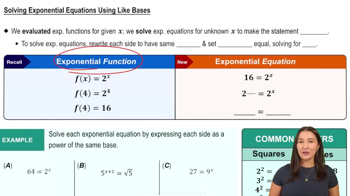Table of contents
- 0. Review of Algebra4h 16m
- 1. Equations & Inequalities3h 18m
- 2. Graphs of Equations43m
- 3. Functions2h 17m
- 4. Polynomial Functions1h 44m
- 5. Rational Functions1h 23m
- 6. Exponential & Logarithmic Functions2h 28m
- 7. Systems of Equations & Matrices4h 6m
- 8. Conic Sections2h 23m
- 9. Sequences, Series, & Induction1h 19m
- 10. Combinatorics & Probability1h 45m
6. Exponential & Logarithmic Functions
Solving Exponential and Logarithmic Equations
Problem 138
Textbook Question
Exercises 137–139 will help you prepare for the material covered in the next section. Solve: x(x - 7) = 3.
 Verified step by step guidance
Verified step by step guidance1
Start by expanding the left side of the equation: distribute x to both terms inside the parentheses, resulting in the equation: x^2 - 7x = 3.
Rearrange the equation to set it to zero by subtracting 3 from both sides: x^2 - 7x - 3 = 0.
Recognize that this is a quadratic equation in the standard form ax^2 + bx + c = 0, where a = 1, b = -7, and c = -3.
Use the quadratic formula to solve for x: x = \frac{-b \pm \sqrt{b^2 - 4ac}}{2a}.
Substitute the values of a, b, and c into the quadratic formula to find the solutions for x.
Recommended similar problem, with video answer:
 Verified Solution
Verified SolutionThis video solution was recommended by our tutors as helpful for the problem above
Video duration:
2mPlay a video:
Was this helpful?
Key Concepts
Here are the essential concepts you must grasp in order to answer the question correctly.
Quadratic Equations
A quadratic equation is a polynomial equation of the form ax² + bx + c = 0, where a, b, and c are constants, and a ≠ 0. In the given problem, x(x - 7) = 3 can be rearranged into a standard quadratic form by moving all terms to one side, allowing us to apply methods for solving quadratics, such as factoring, completing the square, or using the quadratic formula.
Recommended video:

Introduction to Quadratic Equations
Factoring
Factoring is the process of breaking down an expression into simpler components, or factors, that when multiplied together yield the original expression. In this case, the left side of the equation x(x - 7) can be factored, and understanding how to factor polynomials is essential for simplifying and solving quadratic equations effectively.
Recommended video:
Guided course

Factor by Grouping
Zero Product Property
The Zero Product Property states that if the product of two factors equals zero, then at least one of the factors must be zero. This principle is crucial when solving quadratic equations, as it allows us to set each factor equal to zero after factoring the equation, leading to the possible solutions for x in the equation x(x - 7) - 3 = 0.
Recommended video:

Product, Quotient, and Power Rules of Logs

 4:46m
4:46mWatch next
Master Solving Exponential Equations Using Like Bases with a bite sized video explanation from Callie
Start learningRelated Videos
Related Practice













